The Phases of the Moon
by Dr Jamie Love © 1997 - 2011
© 1997 - 2011
 © 1997 - 2011
© 1997 - 2011
Now that you have a thorough understanding of the Earth-Moon system
it is time to introduce the Sun.
The phases of the Moon are caused by the positions of the Earth,
Moon and Sun. The tides are affected by these positions too.
|
You'll recall that the Earth revolves around the Sun taking
an entire year to complete one revolution. We have our daily night
and day because the Earth rotates - one rotation taking 24 hours.
We see the night sky when our part of the Earth faces away from
the Sun.
Now, let's add the Moon into this. The Moon produces no light
of its own. It merely reflects the sunlight. Therefore, at any one time the Moon (like the Earth) has a night side
and a day side that depends upon the position of the Sun.
We can see the Moon only from the Earth (assuming you are not
a space traveler | 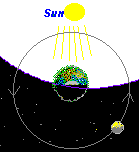 |
Let's look at the phases in some detail. In the drawings below assume that the Sun is shining from "above" (the top of your screen) as indicated by the yellow rays of light. Note that the Moon orbits the earth counterclockwise (anticlockwise). That's also the same direction as the Earth's spin and the same direction as the Earth's orbit.
As you study these images, imagine how the Moon would look from some point on Earth. Would it be visible at all? If it was visible, what parts of it would be sunlit? How would the Moon appear to move through the sky from hour to hour or from day to day? These are not trivial questions. Take your time and think about these questions as we go through this section.
|
The New Moon occurs when the Moon is directly on the Sun side
of the Earth, or to put that another way, the Moon is "new" when it is
between the Earth and the Sun.
The New Moon rises and sets along with the Sun at about the same time. Since the New Moon has its shadowed face to us we don't see the New Moon very well and for all practical purposes the New Moon is "invisible". It is interesting to note that the New Moon's far side (the "dark side") is fully in the sunlight! | 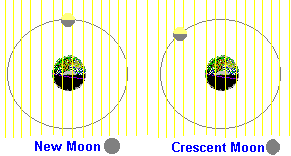 |
A few days later the Moon has moved and a sliver of the Moon's
Earth side ("our side") is illuminated by the sunlight.
This produces a Crescent Moon soon after sunset. That's right, you can see the Crescent Moon at sunset. Imagine you are standing on the far left side of this image of the Earth (using the image on the right - for Crescent Moon), just barely in the shadow. That is your position soon after sunset. You should imagine that if you were at that point, you would be in the dark and able to see the Crescent Moon low on your western horizon. It sets soon after sunset. Take a good look at this image and convince yourself that what I just said is true.
A Crescent Moon also occurs during the opposite part of its orbit - before sunrise in the east.
If you look carefully on a clear night you can actually see that the rest of the Crescent Moon is very dimly lit. This is caused by sunlight reflecting off the Earth and shining on the Moon, and then shining back down to Earth where we can see it. This light is called Earthshine and it causes a nice glow.
|
As the Moon continues in its orbit it moves into a position in
which it makes a right angle with the Earth-Sun line. This
causes half the Moon to be lit (but it's ALWAYS half lit somewhere! Right?). Some folks call this a "Half
Moon" but astronomers prefer to call it a First Quarter
Moon to remind us that there is another quarter illuminated
on the Moon's far side.
A few days later the Moon becomes a Gibbous Moon. A Gibbous Moon is just a moon more than a quarter but not full.
| 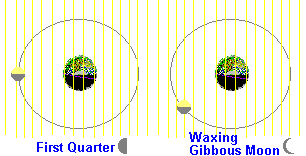 |
As the days go by the Moon moves into a position directly along the Earth-Sun line but this time it is opposite its position when it was a New Moon.
|
Now it's fully illuminated by the Sun and it's
a Full Moon. Notice that during the Full Moon the far side (the "dark side")
of the Moon really is dark.
Due to the positions involved, A Full Moon rises (in the east) at about the same time as the Sun sets (in the west). Take a good look at this diagram to understand why it would happen that way. | 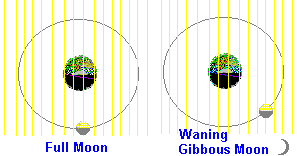 |
Romantics love a Full Moon but astronomers hate it! A Full Moon is so bright (magnitude -12.7) that it overpowers the night sky and makes it difficult to see dim objects. Even Lunar astronomers hate a Full Moon because it's too bright a sight through the telescope. (That makes it hard to see the fine details.) During a Full Moon the Moon is illuminated straight on so there are few shadows. Probably the only favorable thing that an astronomer can say about the Full Moon is that it shows the rays from craters very well. (More on that in our next lesson.)
Fortunately the Full Moon doesn't last forever. The edge of the
Moon that was once a crescent starts to "melt" away
as the Moon continues its orbit. This moon is now "waning".
Wane is a rather old-fashioned word meaning "decline"
so it is a good description.
After the Full Moon comes a Waning Gibbous Moon because it is gibbous (more than a quarter but less than full) and waning (becoming less illuminated each night).
|
The Waning Moon continues to wane as it moves in its orbit and
it becomes a Last Quarter Moon when it's again at right
angle to the Earth-Sun line. This time it is the other
half of the Moon that is lit.
With each passing night the Moon continues to wane and it produces an Old Moon. This is
another Crescent Moon, but it is the opposite side that is illuminated as a crescent. The Old Moon rises just before sunrise and, if you study this diagram to the right, you should understand why.
| 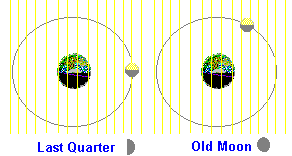 |
Now, try to figure out where a Last Quarter Moon would be at sunrise and compare that to where the First Quarter Moon would be at sunset. For that matter, why not draw these images yourself and work out (roughly) when each phase of the Moon would rise or set and where would each phase would be (in the sky) at sunrise and sunset?
[That's not just an idle thought. It's an exercise that will help you to better understand the phases and how we observe them. You've got a notebook, right? Use it.  ]
]
After the Old Moon the Moon returns to its starting position as a New Moon and the whole process starts over again.
Exactly how long does it take for the Moon to revolve around the Earth?
It takes (exactly) 27.321661 days ("Earth days") for the Moon to complete one revolution around the Earth.
So the time between two Full Moons is about 27.3 days and a "Moon day" equals 27.3 Earth days. Right?
Ah, no.
As the Moon revolves around the Earth, the Earth-Moon system moves
around the Sun and that adds a layer of complication to
the story.
|
In 27.3 days the Earth-Moon system will have moved
about 27o around the Sun. [I got that by dividing 27.3
days (one Moon rotation or orbit) by 365.25 days (the time it takes the
Earth to go around the Sun) to get 0.07 of a circle or
about 27o.] That means the Sun's apparent position will
be "off" by about 27o and that must be taken into account.
You can see in this image how the Sun's rays are at a different angle after 27.3 days but notice that the Moon is oriented exactly as it should be. (This orientation is tracked by astronomers using the position of stars but in my example I am using the orientation of your computer monitor to show you what I mean. It works out the same. The Moon is straight "up".) | 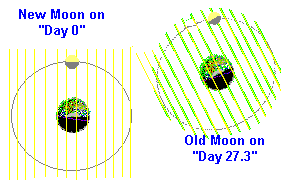 |
Notice that the Moon, as seen from the Earth, is not "new" - it is still an Old Moon because of the way the sunlight strikes it. It will take a few more days for the Moon to move along in its orbit in order to compensate for that change in the Sun's angle of 27o and in the meantime the Earth-Sun system will have moved along even further!
|
When you do all the calculations and make the correct observations
it turns out that it takes about 29.5 days for the New Moon to
return. During that time the Earth-Moon system has moved about
29o around the Sun and the Moon will have gone through
one complete revolution plus another 6.5% of its next revolution.
In this image you can see that the Moon has progressed further around in its orbit so that it now presents itself to Earth as a New Moon. (But notice that this "new New Moon" is not straight "up" as it was on day zero.) | 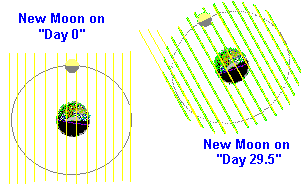 |
So, as you can see, a mere orbital period isn't enough. You have
to take into account the way the Sun's position appears to change.
Of course, astronomers have a name for this. A synodic period
is the time taken for any object in the solar system (not just
the Moon) to return to the same position relative to the Sun
as seen from Earth. The Moon has a synodic period of 29.5 days.
(Actually that's 29 days, 12 hours, 44 minutes and 3 seconds.  )
The Moon returns to its phase during a synodic period so there
are 29.5 days between each New Moon (or Full Moon, or Crescent
Moon, etc.). Also, one "Moon day" equals 29.5 (Earth)
days.
)
The Moon returns to its phase during a synodic period so there
are 29.5 days between each New Moon (or Full Moon, or Crescent
Moon, etc.). Also, one "Moon day" equals 29.5 (Earth)
days.
What's a "normal" period called?
The time it takes an object to complete one revolution with respect to the stars is called a sidereal period. The Moon has a sidereal period of 27.3 days and a synodic period of 29.5 days. The Earth has a sidereal period of 365.25 days but it doesn't have a synodic period. (And if you understand the definition you know why.)
We use the Moon's synodic period to calculate when it will go through its phases. We also use synodic period of the Moon to predict tidal effects.
|
The Sun is much further away from us than the Moon but
the Sun is also much, much bigger (more massive) than the
Moon. The net effect is that the Sun's pull adds a tiny tug to the tides.
When the Moon and Sun line up with the Earth their gravitational pulls combine together producing excessively high tides called spring tides. This has nothing to do with spring seasons and is just an unfortunate name. Regardless, spring tides occur during each Full Moon or New Moon and the Sun's extra tug increases the tidal fluctuation by about a third. Conversely, when the Sun and Moon form a right angle with the Earth, the Sun's gravitational pull on the oceans minimizes the effect of the Moon's pull to cause weak tidal fluctuations called neap tides. These occur when the Moon is in its quarters. | 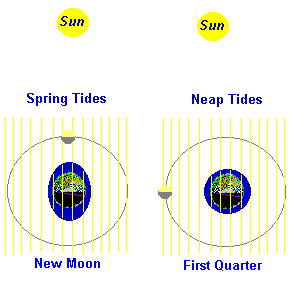 |
That said, other factors can be taken into account in order to estimate the details of these effects. You will recall that tides are delayed about 6 hours due to inertia and momentum and that local geography will disrupt this timing too. Less obvious is the fact that a spring tide of a New Moon will be slightly more excessive that the spring tide caused by a Full Moon. That's because the New Moon and Sun are both "pulling together" (directly) on the oceans. Have a look at the diagram above to understand that effect.
OK. Why don't we have a solar eclipse with each New Moon and a lunar eclipse with each Full Moon?
I've tried to keep this lesson simple by restricting our discussion to the Earth-Moon-Sun system as if it were a flat plane (like the plane of your monitor). In fact, the third dimension makes this all more complex and there is added complexity in the exact shapes of these orbits too. Once I've taught you about those complex problems, in subsequent lessons (in July), we will return to your question.
Certainly the first step is to be sure you understand this lesson and make some observations to help visualize the Moon's motion and its position with respect to the Sun and stars.
Take some time to observe the Moon. (You sure don't need a telescope
to see the events in this lesson!  ) Why not follow the Moon for
the next month or two, noting its position and phase? When does
it rise and what phase is it in? Can you figure out the direction
of the Sun by the phase of the Moon? How does it progress
through the sky? If you take good notes and study the diagrams
I've shown you here, you'll learn that the phases of the Moon
correlate with its rising and setting. If you live along the coast
you can work out the timing of the tides and follow their progress
through a cycle. [You need a large ocean to see tidal effects. Even Lake Superior is too small to have lunar tides.]
) Why not follow the Moon for
the next month or two, noting its position and phase? When does
it rise and what phase is it in? Can you figure out the direction
of the Sun by the phase of the Moon? How does it progress
through the sky? If you take good notes and study the diagrams
I've shown you here, you'll learn that the phases of the Moon
correlate with its rising and setting. If you live along the coast
you can work out the timing of the tides and follow their progress
through a cycle. [You need a large ocean to see tidal effects. Even Lake Superior is too small to have lunar tides.]
Draw a map of the Full Moon's position against the stars and then see if it fits back into place after 27.3 days (the Moon's sidereal period). [In point of fact, it will not line up perfectly but you'll see only a slight difference. I'll explain that in a subsequent lesson.] Once the Moon has returned to its place in the stars (after 27.3 days) what is its phase? When does it return to its phase? And when it returns to its phase, where is it now in the starfield?
You can use your hand to measure the Moon's motion. Remember that your outstretched fist covers about 10o of sky and each finger covers about 2o, so you have a pretty good measuring tool with you right now. While you are at it, notice how "small" the Moon looks compared to your finger. I think you will be surprised to know that you can cover the Full Moon with your smallest finger!
Hey, I've been told that the Moon is bigger on the horizon than when overhead. Why?
This is a popular myth. It's an illusion of the mind. Use your finger or a pencil to measure the size of the Moon at moonrise and again when it is overhead. If you make careful measurements you'll discover that the Moon's size doesn't change regardless of its position. Peoples' minds play tricks on them, especially with things in the night sky.
As you can see, the Moon is a very important part of astronomy. I am amazed at how little thought people give the Moon. Some folks hardly notice it at all. Notice our neighbor and become familiar with its movements, phases and effects.
OK, but it would be nice to know some features on the Moon.
I understand your desire to know more about the Moon's surface and that is the topic of our next lesson.








